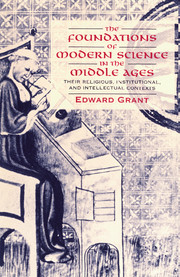 The Foundations of Modern Science in the Middle Ages
The Foundations of Modern Science in the Middle Ages Book contents
- Frontmatter
- Contents
- Preface
- 1 THE ROMAN EMPIRE AND THE FIRST SIX CENTURIES OF CHRISTIANITY
- 2 THE NEW BEGINNING: THE AGE OF TRANSLATION IN THE TWELFTH AND THIRTEENTH CENTURIES
- 3 THE MEDIEVAL UNIVERSITY
- 4 WHAT THE MIDDLE AGES INHERITED FROM ARISTOTLE
- 5 THE RECEPTION AND IMPACT OF ARISTOTELIAN LEARNING AND THE REACTION OF THE CHURCH AND ITS THEOLOGIANS
- 6 WHAT THE MIDDLE AGES DID WITH ITS ARISTOTELIAN LEGACY
- 7 MEDIEVAL NATURAL PHILOSOPHY, ARISTOTELIANS, AND ARISTOTELIANISM
- 8 HOW THE FOUNDATIONS OF EARLY MODERN SCIENCE WERE LAID IN THE MIDDLE AGES
- Notes
- Bibliography
- Index
6 - WHAT THE MIDDLE AGES DID WITH ITS ARISTOTELIAN LEGACY
Published online by Cambridge University Press: 05 June 2012
- Frontmatter
- Contents
- Preface
- 1 THE ROMAN EMPIRE AND THE FIRST SIX CENTURIES OF CHRISTIANITY
- 2 THE NEW BEGINNING: THE AGE OF TRANSLATION IN THE TWELFTH AND THIRTEENTH CENTURIES
- 3 THE MEDIEVAL UNIVERSITY
- 4 WHAT THE MIDDLE AGES INHERITED FROM ARISTOTLE
- 5 THE RECEPTION AND IMPACT OF ARISTOTELIAN LEARNING AND THE REACTION OF THE CHURCH AND ITS THEOLOGIANS
- 6 WHAT THE MIDDLE AGES DID WITH ITS ARISTOTELIAN LEGACY
- 7 MEDIEVAL NATURAL PHILOSOPHY, ARISTOTELIANS, AND ARISTOTELIANISM
- 8 HOW THE FOUNDATIONS OF EARLY MODERN SCIENCE WERE LAID IN THE MIDDLE AGES
- Notes
- Bibliography
- Index
Summary
Many of the Aristotelian principles and concepts described in chapter 4 were retained in the Middle Ages. These concepts – element, compound, matter, form, the doctrine of contraries, the four types of change, celestial incorruptibility, and others – were too fundamental to be abandoned or even altered significantly. Numerous other of Aristotle's arguments and ideas, however, were changed considerably and sometimes wholly replaced. The most significant transformations in Aristotle's natural philosophy during the late Middle Ages, from the standpoint of the history of science, occurred in his treatment of motion. Here the departures were truly dramatic. Aristotle's explanations of natural and violent motion were largely abandoned, especially those on violent motion.
One striking departure occurred in Aristotle's basic formulation as described in chapter 4. There we saw that for Aristotle V∝ F/R, where V is velocity, F is motive force, and R is the total resistance offered to the applied force, a quantity that, presumably, includes the resisting object or body plus the resistance of the external medium in which the motion occurs. To double V, R could be halved and F held constant; or, F doubled and R held constant. To halve V, F could be halved and R held constant; or R doubled and F held constant. Aristotle realized that in halving a velocity F might be reduced to the point where it was smaller than R and therefore unable to move it.
- Type
- Chapter
- Information
- The Foundations of Modern Science in the Middle AgesTheir Religious, Institutional and Intellectual Contexts, pp. 86 - 126Publisher: Cambridge University PressPrint publication year: 1996
